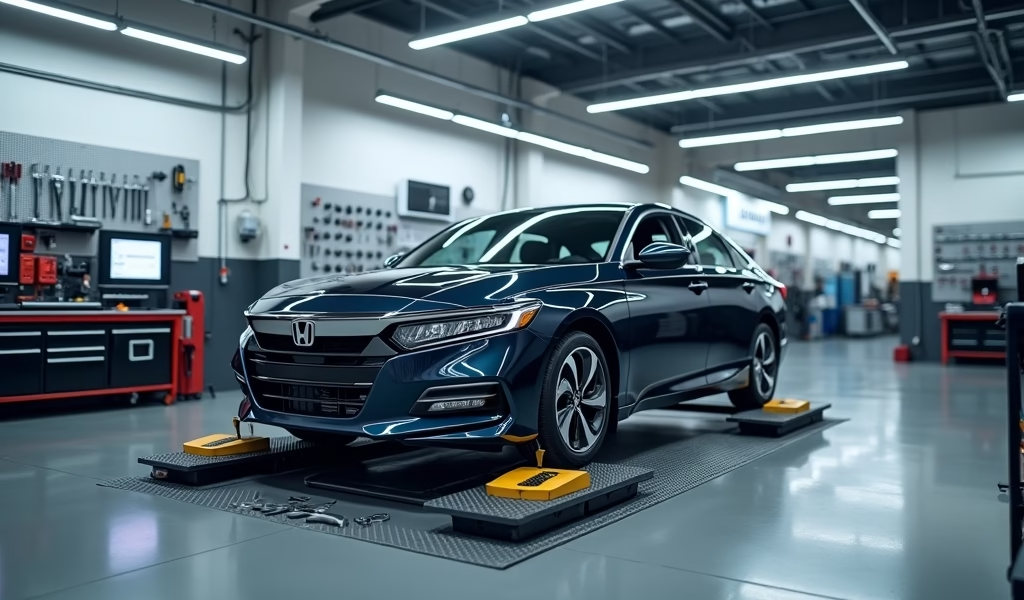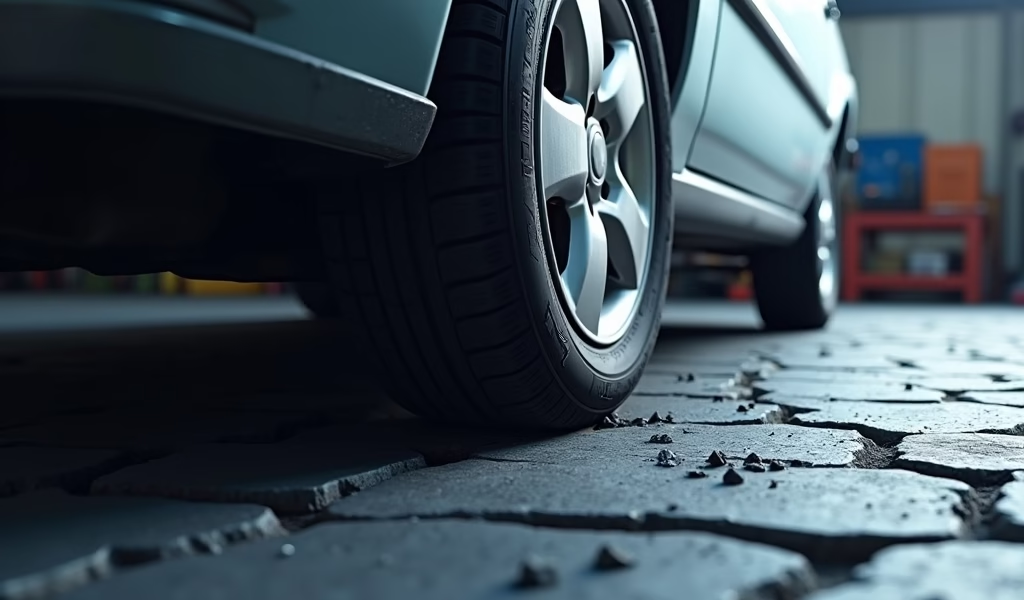Overview
This article provides six practical methods to check your vehicle’s wheel alignment, including examining tire wear patterns, steering wheel position, vehicle pull testing, inspecting suspension components, using the DIY string method, and knowing when professional help is needed. Proper wheel alignment is crucial for safety, fuel efficiency, and preventing premature tire wear, with the article emphasizing that regular checks can save drivers significant money by catching alignment issues early.
Table of Contents
- Understanding Alignment: What’s Really Going On
- Check #1: Uneven Tire Wear Patterns
- Check #2: Steering Wheel Position
- Check #3: Vehicle Pull Test
- Check #4: Visual Inspection of Suspension Components
- Check #5: DIY String Method
- Check #6: Know When To Get Professional Help
- Conclusion: Keeping Your Wheels in Line
- Frequently Asked Questions
Understanding Alignment: What’s Really Going On
When your car isn’t tracking straight and true, it’s not just annoying—it’s costly. Proper wheel alignment might seem like a minor detail, but it affects everything from tire life to fuel economy and safety. In my 20 years as a mechanic, I’ve seen countless drivers ignore the subtle signs until they’re facing a $600 tire replacement bill.
Alignment refers to the precise angles of your wheels relative to the road and to each other. These angles—camber, toe, and caster—determine how your tires contact the pavement. When they’re spot-on, your car handles predictably and your tires wear evenly. When they’re off, even slightly, problems cascade quickly.
Let’s walk through six practical ways to check if your alignment needs attention, using tools and techniques that won’t require an engineering degree.
Check #1: Uneven Tire Wear Patterns
Your tires are like four rubber diaries recording every alignment issue your car experiences. Learning to read these wear patterns can save you hundreds in unnecessary replacements.
What To Look For:
- Inner edge wear: If the inside edges of your tires are balding while the outside looks fine, you’ve likely got excessive negative camber. The top of your wheel is tilting inward too much.
- Outer edge wear: Conversely, if the outer edges are wearing faster, you’re dealing with too much positive camber—the wheels are tilting outward at the top.
- Feathering: Run your hand across the tire tread. Feel how one side of each tread block is higher than the other, creating a sawtooth pattern? That’s a classic sign of toe misalignment.
- Center wear: While not alignment-related, if the center of your tread is wearing faster, your tires are over-inflated. Conversely, worn edges with a good center suggest under-inflation.
To check properly, park on level ground with your steering wheel straight. A flashlight helps spot subtle wear that fingers might miss. I recommend checking all four tires, as sometimes rear alignment issues manifest in front tire wear patterns.
Remember that tire wear takes time to develop. If you’ve just hit a massive pothole, the alignment might be fresh out of whack but won’t show tire wear symptoms yet. That’s why it’s important to check using multiple methods.

Check #2: Steering Wheel Position
Your steering wheel should sit level when you’re driving straight—it’s that simple. Yet I’m amazed how many folks adapt to driving with a crooked wheel without realizing it’s a glaring alignment red flag.
Find a straight, flat stretch of road without much crown (that slight sideways slope for drainage). Drive straight and check if your steering wheel emblem is perfectly horizontal. Many steering wheels have horizontal design elements specifically to make this check easier.
- If your car tracks straight but your wheel is off-center, you’re looking at a toe alignment issue.
- If both your car pulls AND your wheel is off-center when trying to drive straight, that could indicate a more significant front-end problem.
This check costs nothing but pays dividends in early problem detection. When your vehicle was manufactured, engineers calibrated everything to work harmoniously with a centered wheel. Anything else is a compromise to your vehicle’s handling and tire wear.
I recommend combining this check with a comprehensive brake inspection since these systems work together to control your vehicle’s direction and stopping power.
Check #3: Vehicle Pull Test
The vehicle pull test reveals alignment issues that might be subtle enough to miss during normal driving. It’s straightforward but should be done safely.
How to Perform the Pull Test:
- Find a straight, flat road with minimal traffic and no steep crown.
- Drive at about 35-45 mph to eliminate wind effects but stay safe.
- Briefly (and carefully!) release your grip on the steering wheel—just enough to feel the natural tendency of the car.
- If your car immediately veers left or right, you’ve likely got an alignment issue.
Before concluding it’s definitely alignment-related, eliminate these common false positives:
- Uneven tire pressure (check all four tires when cold)
- Dramatically different tread depths between left and right tires
- Road crown (repeat the test on different road sections)
- Brake caliper issues (these typically cause pull only during braking)
A properly aligned vehicle should track straight or have just a very slight drift. Anything more pronounced deserves attention. According to the National Highway Traffic Safety Administration, poor alignment can reduce vehicle control during emergency maneuvers, making this check important for safety, not just tire wear.
Check #4: Visual Inspection of Suspension Components
Sometimes alignment issues aren’t about adjustments—they’re about worn or damaged parts. A visual inspection can catch these problems before they become dangerous.
For this check, you’ll need good lighting, and ideally, access to a vehicle lift or jack stands (always follow proper safety procedures). What we’re looking for are components that affect wheel position:
- Tie rod ends: Look for torn boots, grease leakage, or excessive play.
- Ball joints: Check for deteriorated boots or looseness.
- Control arm bushings: Inspect for cracks, tears or oil-soaked appearance.
- Strut mounts: Look for broken or severely rusted components.
If you can safely raise the vehicle, grab each front tire at the top and bottom and try to rock it. Excessive movement suggests worn components that no alignment can fix. It’s like trying to straighten a picture frame hung on a loose nail—the underlying issue must be addressed first.
Many alignment problems develop gradually after components begin to wear. Regular tune-up service can catch these issues before they progress to major alignment problems that affect vehicle handling and safety.

Check #5: DIY String Method
I love sharing this old-school technique because it costs nothing but can reveal alignment issues with surprising accuracy. The string method lets you visualize your vehicle’s toe alignment—whether your wheels are pointing inward or outward relative to each other.
What You’ll Need:
- A long piece of string (at least twice your vehicle’s length)
- Four jack stands (or similar stable objects)
- Measuring tape
- A helper (optional but helpful)
Step-by-Step Process:
- Park your car on a flat, level surface with wheels pointing straight ahead.
- Position jack stands outside each wheel, creating a rectangle around your vehicle.
- Run string around all four stands, creating a perfect rectangle outside your car’s wheels.
- Adjust the string height to align with wheel centers.
- Measure the distance from the string to the front edge of each front tire.
- Measure again at the rear edge of the same tires.
If your front wheels have correct toe alignment, these measurements should be very close to identical. If the front measurements are greater than the rear (string is farther from the front edge), you have toe-in. If rear measurements are greater, you have toe-out.
While this method won’t replace professional alignment equipment, researchers from SAE International have found that simple measurement techniques can identify alignment issues with enough accuracy to determine when professional service is needed.
Remember: This method checks toe alignment only. Camber and caster require more specialized equipment to measure accurately.
Check #6: Know When To Get Professional Help
Sometimes the smartest DIY move is recognizing when to call in the professionals. Certain warning signs should prompt immediate attention, regardless of what your home checks reveal.
When to Head to the Shop Immediately:
- After hitting a major pothole or curb (especially if handling changed suddenly)
- When experiencing vibration in the steering wheel at specific speeds
- If your vehicle pulls strongly during braking (could indicate brake service is needed alongside alignment)
- When you notice rapid or severely uneven tire wear developing
- If your steering wheel doesn’t return to center properly after turns
Professional alignment service typically costs between $75-$200 depending on your vehicle and location. While this might seem expensive, consider that a single set of prematurely worn tires can cost $600-$1,200 to replace. The math makes alignment a bargain.
Most manufacturers recommend alignment checks every 15,000 miles or annually, but I suggest checking after any significant suspension work or if you regularly drive on rough roads. For performance vehicles, twice-yearly checks can save substantial money in the long run.
Remember that modern vehicles with advanced driver assistance systems (ADAS) may require special calibration procedures after alignment adjustments. These specialized shops have the equipment to ensure all systems work together properly.
Conclusion: Keeping Your Wheels in Line
Proper wheel alignment isn’t just about avoiding uneven tire wear—it’s about safety, fuel efficiency, and driving comfort. The six checks we’ve covered give you a comprehensive toolkit to identify alignment issues before they drain your wallet or compromise your safety.
Start with the simplest checks—watching for uneven tire wear and noticing if your steering wheel sits crooked when driving straight. These alone catch most alignment problems early. If you’re comfortable getting more hands-on, the string method provides valuable insights without special tools.
Remember that alignment is a precision service requiring specialized equipment for final adjustments. These checks help you determine when it’s time to visit a professional, not replace that service entirely. Think of them as your early warning system.
By staying vigilant about your vehicle’s alignment, you’re not just extending tire life—you’re ensuring predictable handling in emergency situations, maximizing fuel economy, and protecting your suspension components from undue stress. That’s something every driver can appreciate, whether you’re maintaining a family sedan or a performance vehicle.
Frequently Asked Questions
How much does a wheel alignment typically cost?
Wheel alignments typically cost between $75-$200 depending on your vehicle type and location. Four-wheel alignments cost more than front-end only alignments but provide more comprehensive correction.
How often should I get my alignment checked?
Most manufacturers recommend alignment checks every 15,000 miles or once a year. Check more frequently if you regularly drive on rough roads or hit potholes.
Can I drive with bad alignment?
While you can physically drive with bad alignment, it causes accelerated and uneven tire wear and can affect handling. Severe alignment issues can create unsafe driving conditions, especially during emergency maneuvers.
Will new tires fix alignment problems?
New tires won’t fix alignment problems and will simply wear unevenly like your old tires. Always address alignment issues before or when installing new tires to protect your investment.
What’s the difference between balancing and alignment?
Tire balancing corrects weight distribution around the tire/wheel assembly to prevent vibration. Alignment adjusts the angles of the wheels to each other and the road surface for proper handling and even tire wear.

